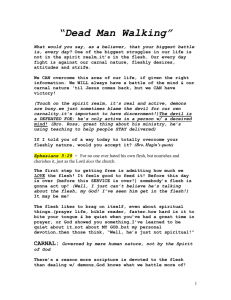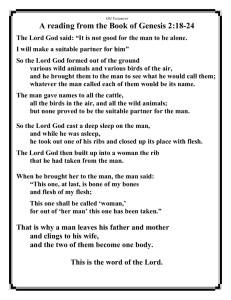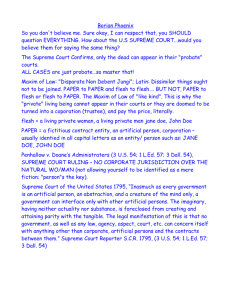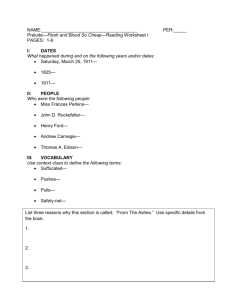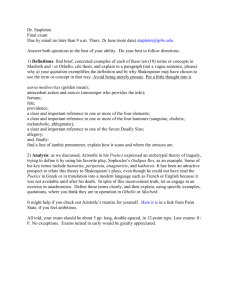Concilium--The Flesh of the World--12-29
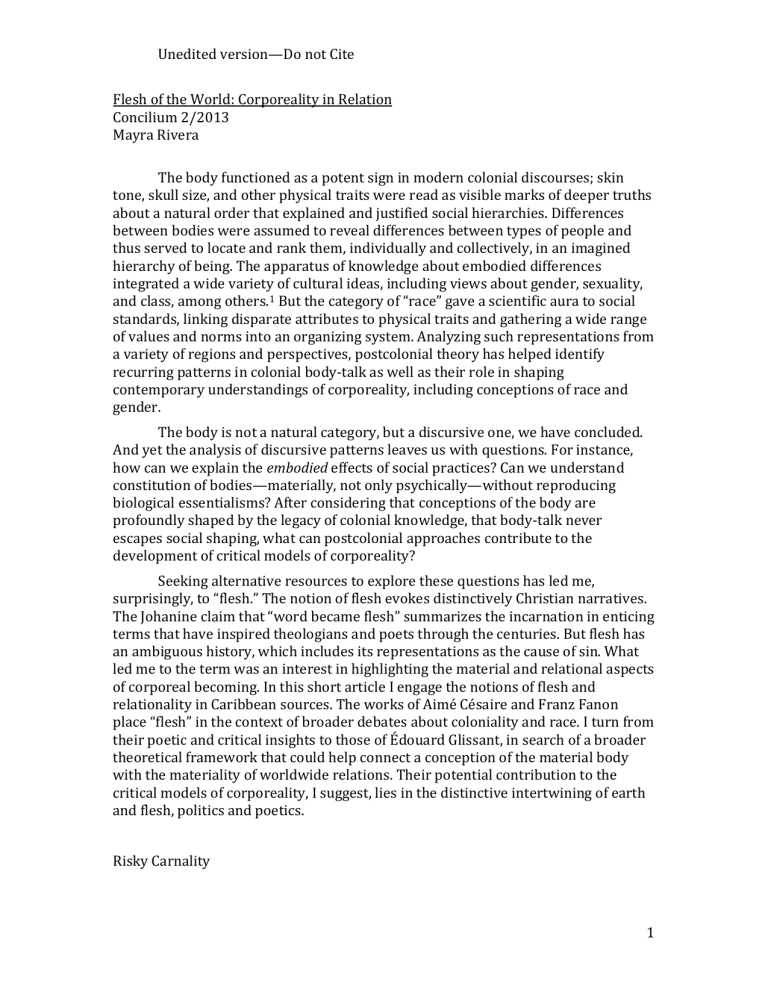
Unedited version—Do not Cite
Flesh of the World: Corporeality in Relation
Concilium 2/2013
Mayra Rivera
The body functioned as a potent sign in modern colonial discourses; skin tone, skull size, and other physical traits were read as visible marks of deeper truths about a natural order that explained and justified social hierarchies. Differences between bodies were assumed to reveal differences between types of people and thus served to locate and rank them, individually and collectively, in an imagined hierarchy of being. The apparatus of knowledge about embodied differences integrated a wide variety of cultural ideas, including views about gender, sexuality, and class, among others.
1 But the category of “race” gave a scientific aura to social standards, linking disparate attributes to physical traits and gathering a wide range of values and norms into an organizing system. Analyzing such representations from a variety of regions and perspectives, postcolonial theory has helped identify recurring patterns in colonial body-talk as well as their role in shaping contemporary understandings of corporeality, including conceptions of race and gender.
The body is not a natural category, but a discursive one, we have concluded.
And yet the analysis of discursive patterns leaves us with questions. For instance, how can we explain the embodied effects of social practices? Can we understand constitution of bodies—materially, not only psychically—without reproducing biological essentialisms? After considering that conceptions of the body are profoundly shaped by the legacy of colonial knowledge, that body-talk never escapes social shaping, what can postcolonial approaches contribute to the development of critical models of corporeality?
Seeking alternative resources to explore these questions has led me, surprisingly, to “flesh.” The notion of flesh evokes distinctively Christian narratives.
The Johanine claim that “word became flesh” summarizes the incarnation in enticing terms that have inspired theologians and poets through the centuries. But flesh has an ambiguous history, which includes its representations as the cause of sin. What led me to the term was an interest in highlighting the material and relational aspects of corporeal becoming. In this short article I engage the notions of flesh and relationality in Caribbean sources. The works of Aimé Césaire and Franz Fanon place “flesh” in the context of broader debates about coloniality and race. I turn from their poetic and critical insights to those of Édouard Glissant, in search of a broader theoretical framework that could help connect a conception of the material body with the materiality of worldwide relations. Their potential contribution to the critical models of corporeality, I suggest, lies in the distinctive intertwining of earth and flesh, politics and poetics.
Risky Carnality
1
Unedited version—Do not Cite
The title for this article comes from Return to the Native Land, a poem by the renowned Martinican writer and politician Aimé Césaire. In this part of the long poem, Césaire pushes against European standards for greatness, and praises those who are not known for their inventions or conquests, but can claim a different kind of honor. They are, he says: truly the eldest sons of the world open to all the breaths of the world meeting-place of all the winds of the world undrained bed of all the waters of the world spark of the sacred fire of the World flesh of the flesh of the world, throbbing with the very movement of the world!
2
Flesh of the flesh of the world: this is not the language, much less a writing style, of postcolonial thought I would have recognized before beginning to search for
Caribbean writings about the body. Looking for the body, I found the world: breaths, winds, waters, and sacred fire—and flesh. But what kind of discourse is this? And why turn to flesh?
“Flesh” has a bad reputation. Talk of flesh evokes images of sin, decay, and death. If one takes a step closer to the Latin equivalent—to the word “carnal”—the associations are even more dubious: passions and uncontrolled appetites, the indecent. These associations, which are contiguous with Christian representation of flesh as the underlying principle or cause of sinfulness, are also implicit in representations of racialized peoples as especially carnal.
3 Tellingly, in his commentary on Glissant’s work, Michael Dash comments: “Associations of carnality are not new for the Caribbean. For a long time, the Caribbean has been trapped in a discourse that accentuates carnality.” 4 While he does not distinguish clearly between “body” and “flesh,” Dash refers to the feminization of the Caribbean in relation to the European metropolis, assuming common associations between flesh, sensuality, femininity, and race. The use of flesh needs to be understood in relation to these complex discursive connections and displacements, but Césaire’s poem represents an attempt to use that term to challenge the devaluation of Caribbean peoples.
Fanon included a brief assessment of this retrieval of flesh in Black Skin,
White Masks, published in 1952 and now considered a key text in the canon of postcolonial studies. The chapter entitled “The Lived Experience of the Black” locates the discussion of embodiment explicitly in the context to colonial racialization. One of the most remarkable features of this essay is its style. It uses corporeal language to draw the reader into the disturbing experiences it describes, how discourses mark, wound, incite, elevate, or shatter bodies.
2
Unedited version—Do not Cite
Fanon’s argument is divided in two parts: one relates to European discourses, the other to Caribbean ones. In the first part he adopts and shows the limits of the phenomenology of French philosopher Maurice Merleau-Ponty, which described the constitution of the body in relation to the world. “I came to the world imbued with the will to find meaning in things, my spirit filled with the desire to attain the source of the world,” Fanon affirms, as if quoting from a phenomenology textbook. But there is racism. Martinique was hardly out of the reach of colonial/racializing forces, but there he knew about them intellectually. In France he experienced their effects intimately in his flesh. Phenomenological descriptions of bodily constitution did not include what he underwent. His encounters with others were always mediated by racist mythologies: stories about primitivism, savagery, and biological deficiency. All this stood in the way of his attempts to relate meaningfully with the world he now inhabited. In an instant, the weight of centuries of such stories falls on one person. Under that weight, the sense of a body composed organically in relation to the world, the “corporeal schema,” crumbles.
Another schema becomes visible: one woven by racism. And Fanon laments,
“There are times when the black man is locked into his body.” A self trapped in a body? Is that not the very image we have tried so hard to purge from theological vocabularies? We are our bodies, we insist. But the trope of confinement persists.
Mayra Santos-Febres adopts this same language to say that still in the twenty first century, it is as if we, women of the Caribbean, could not leave the narrow cell of our bodies.
5 Though using similar metaphors, Fanon and Santos Febres are not appealing to the often-criticized theological idea of an interior self, hidden in the body, to which one could turn to find true, unmediated knowledge. On the contrary, the point is that as bodies we are visible and exposed, and societies use that visibility to regulate people’s relations to the world. Colonial codifications of bodies become obstacles for the kinds of relations with the world that would lead to positive corporeal becoming. Social myths and stories may seem abstract and immaterial, but they constitute bodies as much as the material elements that nourish or poison their flesh. These patterns of the socio-political codification of bodily traits have received significant attention in postcolonial works, as I noted at the beginning of this article.
The second part of Fanon’s essay is a critique of strategies intended to
counter colonial narratives and their demeaning representations of blackness. For this Fanon focused on the works of Négritude poets, especially Césaire and
Senegalese Leopold Senghor. The poets were part of an international movement that, starting in Puerto Rico and Cuba at the beginning of the twentieth century, claimed what they assumed to be African cultural and aesthetic values.
6
Fanon cites the verses from Césaire’s poem that I quoted above. Césaire portrayed flesh as constituted by the world. But for him that world is encountered specifically in his native land, to which he says, “Your mud enters in the composition of my flesh,” as he declares the end of dead flesh.
7 He imagines his flesh plunging into the flesh of the world and receiving an embrace that links him to the world.
8
Césaire’s expansive affirmations of the self-world relation did not assume mastery,
3
Unedited version—Do not Cite not even the erasure of weakness or humility. To the contrary, Césaire lists apparent weaknesses systematically, and follows them by repeating in almost liturgical fashion: “I accept this.” But Fanon was clearly troubled by all this. It reminded him of colonial anthropologies that exoticized African culture as a source of primitive religion, animism, and ritualized sex. Fanon was imagining the European gaze. Talk of the elements—winds, water, fire, and flesh—immediately sparked fears of primitivism. And Fanon would have none of it! He aspired to be a man among men.
Freedom could not be found in stories about the past, he insisted. Indulging in such ecstatic dreams, seeking wisdom in an imagined ancestral culture, or legitimacy in a community of blood relations was to accept representations and assumptions that had to be challenged.
Fanon’s warnings are still crucial, even though his representation of Césaire’s poetics seems reductive; its complexity can hardly be described as a simple denial of rationality or a naïve appeal to bonds of blood. Surely, we cannot afford to adopt a flesh defined as the substance of primitive impulses, a material element assumed to be more securely attached to dark bodies than to lighter ones. We cannot ignore the colonial inflections of flesh—even in its affirmative depictions—and merely reverse inherited dichotomies of matter and rationality. However, I wonder if the pain caused by the colonial logic, and the fear of reproducing it, has led postcolonial studies to develop a kind of allergy to any talk of flesh and earth, instead focusing mostly on social and discursive dimensions of corporeality. In running away from flesh in search of a truly liberated human being, some crucial insights might be lost.
Appeals to a common humanity or abstract notions of culture are not enough to respond to destructive patterns of exclusion based on nationalist territorial claims, much less to struggle for a livable planet. For too long terms like economy, material means, and resources have managed to erase the earth, replacing it with abstract notions of “capital.” In its place, a tradition of thought that explores the intimate reach of colonial and racist ideologies, while attending to the links between notions of identity and the land, the elements, and the sea, offers unique resources for a postcolonial approach to corporeality. The connections between the flesh and the earth in Caribbean literatures are often metaphorical devices, linked to earlier
Negritude poetry by their use of elemental images and allusions to rhythms. For instance, for Nobel laureate poet Derek Walcott, the interface between land and sea, and the plurality of the Caribbean archipelago are sources for understanding relationships in separateness. Cuban novelist and literary critic Antonio Benítez
Rojo even named the diverse Caribbean community as “peoples of the sea.”
Glissant’s poetics of Relation similarly allows the landscape to move through his words. Tellingly his last anthology of poetry was entitled “Earth, Fire, Water, and
Wind.” 9 Yet in Glissant’s work we can see the potential for bringing together
Césaire’s earthy sensibility as well as Fanon’s postcolonial critique in a richly grounded theorization of “Relation.” 10
Earthy Relations
4
Unedited version—Do not Cite
Consonant with Fanon’s critiques of retrievals of real or imagined ancestry,
Glissant rejects the appeals to bonds of blood and explains the problems of the idea of identity as root. Root identity, he observes, is based on the privilege of oneness: it assumes a single creation and is “sanctified by the hidden violence of filiation.” 11 He offers examples of such notions of creation in epic myths and religious texts, which similarly construe filiations as the basis for legitimacy. In Christianity, Glissant argues, even when Jesus is seen as breaking with Judaism, he becomes above all the
Son of God.
12 For Glissant, this is a model of “filiation without the weight of heredity,” one that consecrates filiation and eventually universalizes human history, and even a Darwinian “natural history.” 13 A central concern for Glissant is that the ideals of filiation and Oneness justify conquest and “allow a community to proclaim its entitlement to the possession of the land, which thus becomes a territory.” 14 The effects of such territorial claims are deeply felt in the Caribbean, where many of the islands have been explicitly claimed as possessions of European nations.
15
Conversely, at the metropolitan centers, a notion of identity as root supports the representation of immigrants as aliens.
16
Thinking about the One in these universalizing ways fails to approach the All.
The alternative to the territorial mindset is thus neither the production of competing narratives of filiation nor the idea of a universal humanity. Instead
Glissant proposes an imaginary of Relation. “We propose neither humanity’s Being nor its models. We are not prompted solely by the defining of our identities but by their relationship to everything possible as well—the mutual mutations generated by this interplay of relations. Creolizations contribute to Relation but not to universalize.” Negritudes, ideas of Frenchness, of Latinaness, he argues, are “all generalizing concepts—more or less innocently.” 17 Relation is not a substitute for a universal and, most importantly, it does not “authorize an ecumenical detachment.”
To the contrary, it seeks to sense the entanglements of worldwide relations.
The notion of Relation thus leads to envisioning land not as territory but as a place where one “gives-on-and-with” (donner-avec).
18 The aim is neither to seize and control, nor to passively consume, but to enter into a form of participation that expresses itself in relationships with the natural surroundings and in the protection of the land. This is clearly different from claims to protect a territory by building fences, guarding borders, or bolstering purity of lineage or language. Glissant describes it as a “complicity of relation.” From this perspective, the specificity of a community is not simply a pronouncement of entitlement but something to be put into action.
19 “Passion for the land where one lives is an action we must endlessly risk.” 20 What actions are undertaken depend on the context and include choices about how one moves and what one eats. For Martinique, Glissant suggests eating locally grown breadfruit, for instance. One can add multiple examples from proliferating movements seeking to recover past models of sustenance agriculture as responses to economic and ecologic crises. The bases of such decisions are not absolute principles, but relational necessities—and they demand being mindful of the material specificity of human lives. As Césaire put it, mud enters into the composition of flesh.
5
Unedited version—Do not Cite
Glissant’s suggestion to “Integrate what we have, even if it is sea and sun, with the adventure of a culture that is ours to share and for which we take responsibility,” can also inspire theological adventures that integrate the materiality of worldly relations in the thought of corporeality, one that addresses particular ways of inhabiting the world, connecting to its rhythms, perceiving its movements, and caring for its health.
21 As I envision it, a model of corporeality informed by
Glissant’s poetics of relation would consider elemental relations as integral parts in discussion about place, beyond appeals to real or imagined roots. It would see practices of passionate connections to the earth as modes of carnal flourishing—of positive incarnations. Instead of focusing exclusively on the relationships between body and soul, it would include the constitutive relation between body and soil.
The Political and the Sacred
Glissant distinguishes between two ecological orientations. The first one is ecology as political action, which he affirms. To this he opposes ecology as mysticism, which he denounces as an extension of the sacred. The latter for him is inherently linked to the logic of the One—of one creation, of one lineage—and thus to exclusivism and intolerance. Such a dichotomy between the political and the sacred is common in political philosophies, but Glissant’s argument is more nuanced—and thus also more ambiguous. He sees in the books concerning the sacred “the germ of the exact opposite” of their territorial claims that undo the univocity of the One, of their “totalitarian certainty.” 22 Their oneness is never successfully or absolutely unified; despite their appeals to roots, they are in effect
“books of errantry.” And he wonders whether the world might be needing new versions of such works, where assertions of political strength coexist with “the rhizome of a multiple relationship with the Other.” This would entail, Glissant muses, “basing every community’s reasons for existence on a modern form of the sacred, which would be, all in all, a Poetics of Relation.” 23
While writing explicitly against totalitarian thinking—a self-important
Oneness—Glissant does not simply refuse any thought of the All. Instead, he emphasizes the complex and dynamic character of worldwide relations. The association of this Poetics of Relation with previous notions of the sacred seems to be based, at least in part, on their role in grounding ethical claims for the existence of every community. The grounds for such claims, and thus for the protection of diversity at the heart of relation, would not be an external deity dictating the order of creation from the beginning. But it seems to imply an appeal to a reality that does not derive from the individuals or collectivities it shapes, and thus one that cannot be fully explained based on their production or achievements. The community exists in relation to something of which it cannot give a full account. This would be a nondogmatic thought of the sacred that refuses illusions of absolute certainty. Given the sheer plurality of differentiations in Relation, the totality cannot be known. Not knowing it is not a weakness, he argues. But “not wanting to know it certainly is….
[W]e imagine it through a poetics.” 24
6
Unedited version—Do not Cite
Those of us familiar with the discourse of negative theology, might find these statements oddly resonant, and suggestive of a similar sensibility and attitude toward knowledge. Apophatic theology asserts that the infinite cannot be fully known, and yet we persist seeking, addressing, and naming it—however inadequately. Yet apophatic theologies seldom include pronouncements of an ungraspable cosmos; they usually assert the ineffability of God without extending that attribute to the world or other creatures.
25 Clearly, Glissant’s “totality” is not
God. The apophatic gestures of his poetics do not derive from the infinity of God, but from the boundless and dynamic interdependence of all there is. Still he is not merely noting the limits of knowledge and language; he speaks affirmatively of the
“world’s poetic force” alive within us.
26 Indeed, he seeks a poetics that can orient thought toward what he calls “the Other of thought”—a mindful participation in
Relation.
Dominant modes of rationality are not enough to inspire the persistence needed for “imagining a love of the earth”—as Glissant puts it. This love might seem impossible, however, when eco-social situations are dire and when all concepts seem inadequate. Otto Maduro argues that knowledge is not simply, a “passive capacity to capture things in isolation, to know is the particular ability to intervene in reality by imagining relationships among elements that emerge from collective and individual experience.” It entails an “imaginative reconstruction of relations.” 27
In circumstances of exhausting and devastating problems, Maduro suggests, it becomes “all the more important and urgent to develop the capacity of knowing what hasn’t existed before and of imagining what might be feasible.” Our times demand re-imagining material relationships with others and the world—beyond the limits of what has already existed. Furthermore, “To oppose the disturbing affective standardization of peoples, whose affect has been diverted by the processes and products of international exchange, either consented to or imposed, it is necessary to renew the visions and aesthetics of relating to the earth.” 28 We need oftendismissed forms of knowledge, such as poetic and other aesthetic practices. I assume these can include the wisdom emerging from theological traditions, but not be limited to them.
Glissant argues that the “highest point of knowledge is always a poetics.” 29
Perhaps this broadening of knowledge can prompt us to re-read Césaire’s carnal poetics as a vision and aesthetic to inspire that love of the earth that Glissant saw as almost impossible, and yet crucial. I imagine these materializing through political action as well as mystical sensibilities—weaving theology and poetics. Seeking relationships that may no longer or not yet exist: between our particular cultures and specific acts of passion toward the earth, between past wounds and present wisdom, between our always-already-social bodies and the flesh of the world.
7
Unedited version—Do not Cite
Burrus, Virginia. Begotten, Not Made, Conceiving Manhood in Late Antiquity:
Stanford University Press, 2000.
Césaire, Aimé. Cahier D'un Retour Au Pays Natal. Paris: Présence Africane, 1983.
Dash, J. Michael. "Writing the Body: Edouard Glissant's Poetics and Re-Membering."
World Literature Today 63, no. 4 (1989): 690-12.
Fanon, Frantz. Black Skin, White Masks. New York: Grove Press, 1967.
Glissant, Édouard Poetics of Relation. Translated by Betsy Wing. Ann Arbor: The
University of Michigan Press, 1997.
Maduro, Otto. Mapas Para La Fiesta: Reflexiones Latinoamericanas Sobre La Crisis Y
El Conocimiento: AETH Books, 1999.
McClintock, Anne. Imperial Leather: Race, Gender and Sexuality in the Colonial
Contest: Routledge, 1995.
Santos Febres, Mayra. Sobre Piel Y Papel. San Juan: Ediciones Callejón, 2012.
Stoler, Ann Laura. Race and the Education of Desire: Foucault's History of Sexuality
and the Colonial Order of Things. Durham and London: Duke University Press,
1995.
Young, Robert J. C. Colonial Desire: Hybridity in Theory, Culture and Race. London and
New York: Routledge, 1995.
1 Some early key contributions in this area are Anne McClintock, Imperial
Leather: Race, Gender and Sexuality in the Colonial Contest (Routledge, 1995). Robert
J. C. Young, Colonial Desire: Hybridity in Theory, Culture and Race (London and New
York: Routledge, 1995). Ann Laura Stoler, Race and the Education of Desire:
Foucault's History of Sexuality and the Colonial Order of Things (Durham and London:
Duke University Press, 1995).
2 Césaire, Cahier d’un retour au pays natal, cited in Frantz Fanon, Black Skin,
White Masks (New York: Grove Press, 1967), 124.
3 For a more detailed description of these associations see my “Carnal
Corporeality: Tensions in Continental and Caribbean Thought,” Concordia
internationale zeitschrift für philosophie, forthcoming.
4 J. Michael Dash, "Writing the Body: Edouard Glissant's Poetics and Re-
Membering," World Literature Today 63, no. 4 (1989): 610.
5 Mayra Santos Febres, Sobre Piel Y Papel (San Juan: Ediciones Callejón, 2012),
56.
6 The movement had already started in Puerto Rico and Cuba in the 1920s, with poets like Luis Palés Matos and Nicolás Guillén. By the 1930s it had taken ground in the Caribbean, and among black intellectuals in the United States and
8
Unedited version—Do not Cite
France. The celebrated poet of Harlem Renaissance, Langston Hughes, translated
Nicolás Guillén’s poetry into English, and the Senegalese Léopold Senghor translated
Langston Hughes’ poetry into French.
7 Aimé Césaire, Cahier D'un Retour Au Pays Natal (Paris: Présence Africane,
1983), 22.
8 Ibid., 47.
9 La terre, le feu, l'eau et les vents: Une anthologie de la poésie du tout-monde
(Galaade, 2010).
10 I am adopting here Glissant’s practice of capitalizing “Relation.”
11 Édouard Glissant, Poetics of Relation, trans. Betsy Wing (Ann Arbor: The
University of Michigan Press, 1997), 143.
12 For a historical analysis of the emergence of sonship as the normative language for the incarnation see Virginia Burrus, Begotten, Not Made, Conceiving
Manhood in Late Antiquity (Stanford University Press, 2000).
13 Glissant, Poetics of Relation, 50.
14 Ibid., 143.
15 For instance, Puerto Rico is still defined as a “territory” of the United States.
16 Glissant, Poetics of Relation, 143.
17 Ibid., 90.
18 Glissant uses the phrase “donner-avec” as an alternative to “comprendre” to counter the appropriative connotations of the latter, as Betsy Wing explains in the
“Translator’s Introduction” to Poetics of Relation.
19 Glissant, Poetics of Relation, 147.
20 Ibid., 151.
21 Ibid., 152.
22 Ibid., 16.
23 Ibid.
24 Ibid., 154.
9
Unedited version—Do not Cite
25 For the integration of the epistemological orientations of apophatic theology and cosmic relationality, see Catherine Keller, The Cloud of the Impossible, forthcoming.
26 Glissant, Poetics of Relation, 159.
27 Otto Maduro, Mapas Para La Fiesta: Reflexiones Latinoamericanas Sobre La
Crisis Y El Conocimiento (AETH Books, 1999).
28 Glissant, Poetics of Relation, 148.
29 Ibid., 140.
10
